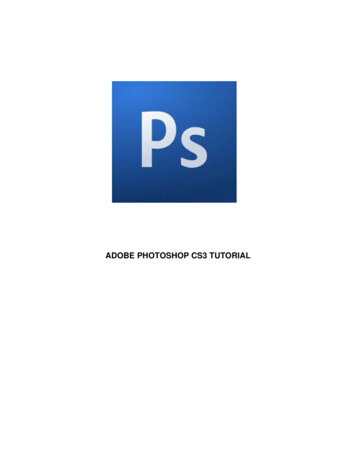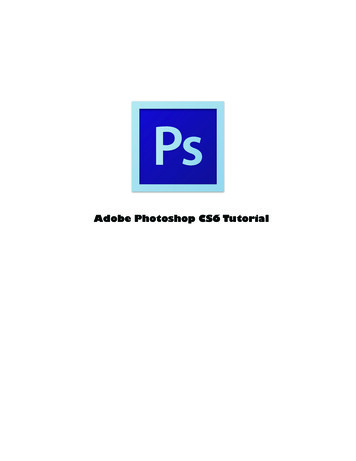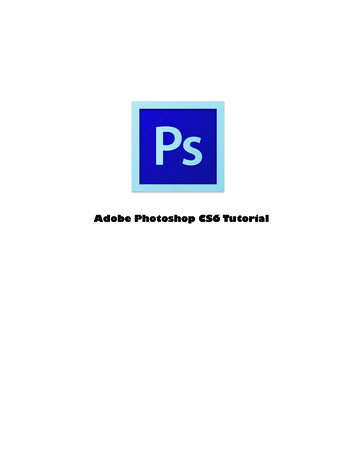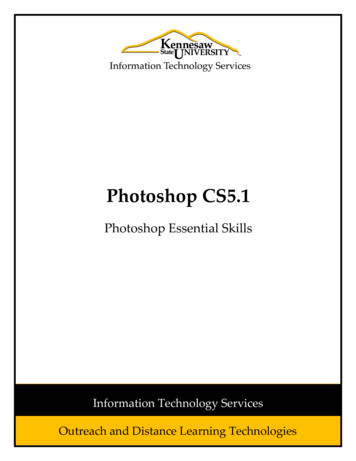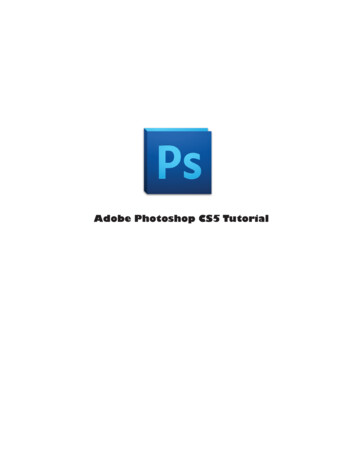
Transcription
Adobe Photoshop CS5 Tutorial
GETTING STARTEDAdobe Photoshop CS5 is a popular image editing software that provides a work environment consistent withAdobe Illustrator, Adobe InDesign, Adobe Photoshop and other products in the Adobe Creative Suite. Thistutorial is an introduction to using Adobe Photoshop. Here you will learn how to get started, how to use theinterface, and how to modify images with basic editing skills.TABLE OF CONTENTS01: Getting Started02: Interface LayoutPg. 503: PalettesPg. 604: ToolboxPg. 1005: Selection ToolsPg. 1106: Alteration ToolsPg. 1207: Drawing and Selection ToolsPg. 1308: Assisting ToolsPg. 1309: Color Boxes and ModesPg. 1410: Basic Image EditingPg. 1411: CroppingPg. 1512: ResizingPg. 1913: CorrectingPg. 2214: SavingPg. 27Pg. 3
1. GETTING STARTED1. Begin by opening Adobe Photoshop CS5.On a PC, click Start Programs Adobe Photoshop CS5, or click on the shortcut on the desktop.On a Mac, click Macintosh HD Applications Adobe Photoshop CS5 Photoshop CS5 shown inFigure 1, or click the icon in the Dock.Figure 1. Navigation to Photoshop CS5 on a MacSetting up the documentSetting up your document correctly from the start will make your job much easier as you work through yourproject. This will require some advanced planning. For example, if your final output will be a brochure, you mayneed to set up your document to be horizontal and double-sided.To create a new document, click File New. This will open the Document Setup dialog box (Figure 2).
Figure 2. Document Setup dialog boxHere you will be able to name your file, set up the correct page size, and orientation for your document.Options include, but are not limited to:Page Size and OrientationChange the page size by typing in new values for width and height. Page size represents the final sizeyou want after bleeds or trimming other marks outside the page. In the Preset dropdown menu youcan find such common sizes as letter, legal, tabloid, etc. Typing in exact values for Height and Width givesyou more control over the size and orientation of your page.ResolutionResolution is the number of pixels on a printed area of an image. The higher the resolution, the morepixels there are on the page, the better the quality of the image. However, high resolution increasesthe size of the file. The standard recommended resolution for printed images is 150-300, for Web images it is 72.Color ModeChoose a color mode that will best fit your project. For example, when making a graphic for a web sitechoose RGB. When making an image for print choose CMYK.Background ContentsChoose the background: white, color or transparent. When you have entered all of your documentsettings click Ok.Opening an image from a diskIf the image you have is saved on a disk, select File Open, and then navigate to the disk drive where yourimage is saved. Choose the image file and click Open. At this point, you may want to save your image under adifferent name so that you can always have the original to fall back on in case of a mistake. To save your file,select File Save As and type in the new name of the file in the dialogue box.
2. Interface LayoutFigure 3. This is the layout of Adobe Photoshop interface.Menu BarIf you look at the top of the screen you will see the Menu bar which contains all the main functions ofPhotoshop, such as File, Edit, Image, Layer, Select, Filter, Analysis, 3D,View, Window, and Help.ToolbarMost of the major tools are located in the Toolbar for easy access.The ImageThe image will appear in its own window once you open a file.Image NameThe name of any image that you open will be at the top of the image window as shown above.PalettesPalettes contain functions that help you monitor and modify images. By default, palettes are stackedtogether in groups. These are the palettes that are usually visible: Color, Adjustments and Layers. If noneof the palettes are visible, go to Window in the Menu bar and choose the palettes you need.
3. PalettesBelow is the description of the most commonly used palettes in Adobe Photoshop CS5. Palettes used formore advanced image editing will be covered in the Adobe Photoshop CS5 Tutorial -Intermediate.Color, Swatches, StyleThe Color palette (Figure 4) displays the current foreground and background colors and RGB values for thesecolors.You can use the sliders to change the foreground and background colors in different color modes.Youcan also choose a color from the spectrum of colors displayed in the color ramp at the bottom of the palette.Figure 4. Color paletteIn the Swatches palette (Figure 5) you can choose a foreground or background color and add acustomizedcolor to the library.Figure 5. Swatches paletteThe Styles palette (Figure 6) allows you to view, select, and apply preset layer styles. By default, a preset stylereplaces the current layer style.You can use the styles in the palette or add your own using the Create NewStyle icon.Figure 6. Styles palette
HistoryThe History palette (Figure 7) stores and displays each action performed allowing you jump to any recentstage of the image alteration. The alterations should be created during the current working session; after savingor closing the document the History palette clears all the contents. Each time you apply a change to an image,the new state of that image is added to the palette. It is important to know that once you click on any of theprevious stages, all the changes that were made after it will be lost.Figure 7. History paletteAdjustmentsThe Adjustment layers palette give you the ability to apply an effect to a group of layers in Photoshop, and thenyou can edit that effect later, while preserving the original layers.Figure 8. Adjustments palette
LayersLayers let you organize your work into distinct levels that can be edited and viewed as individual units. EveryPhotoshop CS5 document contains at least one layer. Creating multiple layers lets you easily control how yourartwork is printed, displayed, and edited.You will use the Layers palette (Figure 6) often while creating a document, so it is crucial to understand what it does and how to use it.A) Layer Visibility -The eye shows that the selected layer is visible. Click on or off to see or to hide a layer.B) Layer Locking Options -Click the checkered square icon to lock Transparency; click the brush icon to lockthe Image; click the arrow icon to lock the Position; click the lock icon to lock all options.C) Layer Blending Mode -Defines how the layer’s pixels blend with underlying pixels in the image. By choosinga particular blending mode from the dropdown menu you can create a variety of special effects.D) Opacity -By typing in a value or dragging a slider you can specify the transparency of the entire layer.D) Fill -By typing in a value or dragging the slider you can specify the transparency. Layers Palette color of theE) Fill -By typing in a value or dragging the slider you can specify the transparency. Layers Palette color of the image orimage or object.object.E) Opacity -By typing in a value or dragging a slider you can specify the transparency of the entire layer.Figure 9. Layer palette
F) Layer Options Menu -Click the black triangle to see the following options: New Layer, Duplicate Layer, DeleteF) LayerLock-The iconetc.showslayer isarelockedand disappearsit is nof thetheoptionspresentedas icons at whenthe bottomof the Layerspalette. theicontounlockthelayer.G) Link Layers - Can be used to link layers together.H) Layer Styles -If a layer has a style, an "Fx" icon shows at the bottom of the Layers palette. Click the little blackG) Layer-Click the black triangle to see the following options: New Layer, Duplicate Layer,triangleto Optionssee style Menuoptions.Layer,-ALayerProperties,the optionspresentediconsinatwhitethe bottomthepartsLayersI)DeleteLayer Maskgrayscaleimage,etc.withSomepartsofpaintedin blackarehidden,parts aspaintedshowing,ofandpaintedinpalette.gray shades showing in various levels of transparency.J) Create New Fill or Adjustment Layer -Have the same opacity and blending mode options as image layers and canbehiddenduplicatedin the same manner as image layers. Click the icon and select an optionH)rearranged,Link Layersdeleted,– Can beusedandto linklayers together.to create a new fill or adjustment layer.K)Group-If-Thisoptionto anorganizeimageswithlayers.ClickLayersthe iconto createfolderforblackI) Layer Stylesa layerhashelpsa style,“F” iconshowsat multiplethe bottomof thepalette.Clickathelittleseverallayers.triangle to see style options.L) Create New Layer -Click this icon to create a new layer.M)DeleteMaskLayer-A-Todelete aimage,layer, withselectpartsa layerin theinLayersdragit to thetrash canicon; or,J) Layergrayscalepaintedblack palettehidden,andpartspaintedin ainted in gray shades showing in various levels of transparency.K) Layer Set -This option helps to organize images with multiple layers. Click the icon to create a folder forseveral layers.L) Create New Fill or Adjustment Layer -Have the same opacity and blending mode options as image layersand can be rearranged, deleted, hidden and duplicated in the same manner as image layers. Click the icon andselect an option to create a new fill or adjustment layer.M) Create New Layer -Click this icon to create a new layer.N) Delete Layer -To delete a layer, select a layer in the Layers palette and drag it to the trash can icon; or, select a layer and click the icon.
4. ToolboxIf you used other Adobe products, such as Illustrator or InDesign, you should be familiar with thetoolbox in Adobe Photoshop CS5 as it shares some of the tools from these applications. If youare a new user of Adobe products, you should keep in mind that you might not need to use all ofthe tools. In this tutorial, only the basic tools will be discussed in depth.Some tools in the toolbar have additional “hidden” tools. These tools have small black triangles inthe right-hand corner. To view the “hidden” tools, click and hold down on any tool that has a blacktriangle in the corner (Figure 10).Figure 10. “Hidden” tools
5. Selection ToolsMoveUsed to select and move objects on the page.Click the tool button, then click on any object on the page you wish to move.MarqueeSelects an object by drawing a rectangle or an ellipse around it.Click the tool button, choose a rectangular or an elliptical marquee. Drag the marqueeover the area of the image you wish to select.LassoSelects an object by drawing a freehand border around it.Click the tool button, drag to draw a freehand border around the are of the image youwish to select.Magic WandCropEye DropperSelects all objects in a document with the same or similar fill color, stroke weight, strokecolor, opacity or blending mode. By specifying the color range or tolerance, you can control what the Magic Wand tool selects.Click the tool button, then click and drag the tool over the part of the image that youwant to keep. Resize the selected area dragging the squares at the sides and corners. Clickthe Return/Enter key when your crop box is sized correctly.Takes color samples from colors on the page and displays them in the Color Boxes.Select the tool, click on the color in the image you wish to sample. The Color Box willdisplay this color.
6. Alteration ToolsHealing BrushCorrects small blemishes in scanned photos.Select the tool, hold down the ALT key and left-click on the base color you need toheal. Then left-click over the blemish.BrushDraws brush strokes of different thicknesses and colors.Select the tool. Then click on the selected area, drag to draw lines. Use the Optionsbar to change the brush, mode, opacity and flow.Clone StampTakes a sample of an image and applies over another image, or a part of thesame image.Select the tool. Hold down the ALT key and left-click on a certain point of the document where you want to start your copy point. Then, put your mouse over whateverpart of the new document you want the picture to go to. Hold down the left mousebutton and drag the mouse across the page to copy the picture.Art HistoryBrushPaints over an image using the source data from a specified history state or snapshot.Select the tool, specify the brush, blending mode, opacity, style, area and tolerance.EraserRemoves part of an existing path or stroke.You can use the Erase tool on paths, butnot on text.Select the tool, click on the part of the image you wish to erase. Drag to erase pixels.GradientApplies a gradient fill to a selected part of the image or to an entire layer.Select an area you wish to apply gradient to, click the tool button, choose a fill in theOptions bar, click on the starting point, and hold the mouse down and drag to the endpoint.BlurBlurs the sharp edges of an image.Select an area where you wish to apply the tool. Click the tool button and choose thebrush, mode, and strength. Drag the brush along the edges.
7. Drawing and Selection ToolsPath SelectionSelects paths and path segments.Select the tool, click anywhere on the path.TypeTypes text on a page. Every time you click the Type Tool on a new portion of the pagea new layer will be created.Select the tool, click on the page and begin to type.You can specify the font and sizein the Options bar.You can also resize and transform the text box by dragging thesquares at the sides and corners. Use the Move Tool to move the text on the page.PenDraws smooth-edged paths.Select the tool, click on the page and drag to draw a path. Click and drag the anchorpoints to modify the path.Line ShapeDraws a straight line. Other shapes that are hidden in this tool are: Rounded Rectangle Tool, Ellipse Tool, Polygon Tool, Line Tool, and Custom Shape Tool.Select the tool, click and drag on the page to draw a line.8. Assiting ToolsHandAllows you to move around within the image.Select the tool, click on the spot on the page, hold the mouse button down, drag tomove in the area.MagnifyMagnifies or reduces the display of any area in your image window.Select the tool, choose Zoom In or Zoom Out in the Options bar, click on the area ofthe image you wish to magnify or reduce.
9. Color Boxes and ModesColor BoxesThe foreground color appears in the upper color selection box and represents a colorthat is currently active. The background color appears in the lower box and represents aninactive color.1. To change the foreground color, click the upper color selection box in the Toolbox.2. To change the background color, click the lower color selection box in the Toolbox.3. To reverse the foreground and background colors, click the Switch Colors icon(the arrow) in the toolbox.4. To restore the default foreground and background colors, click the Default Colors icon(the little black and white boxes) in the toolbox.Note: If you are using the Gradient Tool, the currently selected foreground and backgroundcolors will be the default colors of the gradient.10. Basic Image EditingNow that you know how to find your way around in the Adobe Photoshop CS5 interface and are familiar withthe most common commands, palletes, and tools, you can start doing some basic image editing. In the next fewchapters of this tutorial you will learn how to crop, resize, correct, and sharp/blur your images.
11. CroppingCropping is one of the most basic editing techniques that can improve your images. Cropping helps to bringout the most important features in your image and focus the viewers’ attention on these features. Croppingalso allows you to make your image a standard photo size.There are several ways to crop images in Adobe Photoshop:1. Cropping with the Crop Tool2. Cropping to a specific size3. Cropping with the Marquee ToolCropping with the Crop ToolThe Crop Tool allows you to make a precise selection of an image you wish to edit. To crop with the CropTool, follow these steps:1. Open the image you wish to crop (see Getting Started for detailed instructions).2. Select the Crop Tool from the Toolbox (see Selection Tools for location and description).3. Click on your image once and drag the mouse out to make a cropping border (See Figure 11).Figure 11. Cropping border
4. Resize the border by dragging the squares at the sides and corners till you are satisfied with the wayyour image looks.5. Once you are completely satisfied with your cropped image, press Enter.Note:You can also rotate your cropping border. Move the cursor outside the border, you will see how it turnsinto a double-headed arrow (Figure 12). Drag the arrows in the directions you wish to rotate your selection.Figure 12. Rotating the cropping borderCropping to a specific sizeIf you wish to print your digital photos or other images on standard size photo paper, you will have to cropyour images to a specific size, such as 8x10. To crop an image to a specific size, do the following:1. Open the image you wish to crop.2. Select the Crop Tool from the Toolbox.3. In the Options bar, specify the values for Width and Height (Figure 13).Figure 13. Crop Tool Options bar4. Click in your image and drag the cropping border. Notice that the border is con strained -you cannotmake it wider or longer than the specified values (Figure 14). For example, if you entered 8 for Width and 10for Height, whatever size you make the border, the area within it will fit on an 8x10 photo.
Figure 14. Cropping to a specific size5. Once you are completely satisfied with your cropped image, press Enter.Cropping with the Marquee ToolIf you are in a hurry and need just a simple crop, you can use the Marquee Tool and a menu command. To cropwith the Marquee Tool, follow the steps below:1. Open the image you wish to crop.2. Select the Rectangular Marquee Tool from the Toolbox (see Selection Tools).3. Click and drag the mouse to draw a marquee around the area you wish to crop (Figure 15).
Figure 15. Drawing a marquee4. In the main menu, go to Image Crop (Figure 16). The image will be immediately cropped.Figure 16. Image Crop
12. ResizingResizing in Photoshop can help you print your images in standard photo sizes, resize and preserve the highquality of digital photos, and enlarge small images to a poster size.Resizing to a specific sizeTo resize your image to a preset size, follow the steps below:1. In the main menu, go to File New.2. In the New dialog box, click on the Preset dropdown menu.You will see several preset sizes, such as2x3, 4x6 and 5x7 with the preset resolution of 300 ppi (Figure 17).Figure 17. Preset size in the New dialog box3. Choose the size that you wish and click OK.Note: All the preset sizes are in portrait orientation. If you wish to resize an image with the landscape orientation, you need to create your own preset. To create your own size, do the following:1. Type in the values for Width and Height, for example 7x5.2. Type in your desired resolution (150 ppi for high quality prints, and 72 ppi is good for web images).3. Click the Save Preset button
Resizing digital photosDigital photos usually have large dimensions but low resolution, 72 ppi, which effects their quality when theirsize is decreased or increased. When printed, the photos with the changed size will look pixilated. To resize thedigital photos without loosing the quality, follow these steps:1. Open the digital photo you wish to resize.2. In the main menu, go to View Rulers.You will see the dimension of your photo (Figure 18).Figure 18. Dimensions of a digital photo3. In the main menu, go to Image Image Size.4. In the Image Size dialog box, check the Resample Image box off (Figure 19). Type in your desiredresolution (anything between 150 and 300 ppi). The photo is now 3.208 x 3.083 inches.Figure 19. Changing resolution
EnlargingIf you want to make your digital photo into a poster size image, you can do it in the Image Size dialog box.However, just increasing the dimensions will make the image appear blurry and pixilated. To enlarge the imagewithout loosing the quality, follow these steps:1. Open the digital image you wish to enlarge.2. In the main menu, go to Image Image Size.3. In the Image Size dialog box, make sure the Resample Image box is checked off and choose BicubicSmoother from the dropdown box (Figure 20).Figure 20. Increasing the size by 10 percent4. Change the Document Size measurements to Percent. Type in 110; this will in crease the size of theimage by 10 percent (Figure 20).5. Continue enlarging by 10 percent till you are satisfied with the size.
13. CorrectingDigital cameras tend to cause various problems, such as “red eye” or “hot spots”, if you use flash, or underexposure, if you don’t. In Photoshop, you can correct these problems, as well as adjust the overall color of yourdigital photo.Red Eye RemovalThe digital camera flash is located right above the lens, which causes the “red-eye”; however, you can fix yourphotos easily in Photoshop. To remove the “red eye”, follow the steps below:1. Open a photo you wish to correct.2. Select the Zoom Tool from the Toolbox. Click and drag a rectangle around the eye (Figure 21).Figure 21. Red eye zoomed in3. Make sure your default Foreground and Background colors are black and white.4. Click and hold on the little black triangle of the Healing Brush Tool button and select the Red EyeTool. (Figure 22).Figure 22. Red Eye Tool
5. Click on the red part of the eye and paint, holding down the mouse button.You will see how the redwill disappear (Figure 23).Figure 23. Red eye correctedHot Spot RemovalUsing a flash can also cause another problem -shiny areas on people’s faces or the flash reflection in the shinysurfaces. To correct this problem, follow the steps below:1. Open the photo you wish to correct.2. Select the Clone Stamp Tool from the Toolbox.3. In the Options bar, change the Blend Mode from Normal to Darken (Figure 24).Figure 24. Setting the options for the Clone Stamp Tool4. Set the Opacity to 50 percent.5. Choose a soft-edged brush, set the diameter to 40 or 50.6. tHold down the Shift key and click in the clean area (without “hot spots”) to get a sample of color(Figure 25).Figure 25. Clone Stamp selection7. Paint over the “hot spot”, the light area will gradually darken (Figure 26).Figure 26. Corrected image
Adding FlashIf you took pictures indoors without a flash they will turn out underexposed and dark; in Photoshop, you canmake your photos lighter. To fix underexposed photos, follow these steps:1. Open a digital photo you wish to correct (Figure 27).Figure 27. Underexposed photo2. In the main menu, go to Layers Duplicate. In the next window, name the layer Layer 1.3. Make sure Layer 1 is selected in the Layers palette. In the Blending Mode drop down box, change theBlending Mode to Screen (Figure 28). The whole image will lighten.Figure 28. Changing the Blending Mode
4. Keep duplicating Layer 1 till you are satisfied with the your image (Figure 29).Figure 29. Corrected photoColor AdjustmentColor adjustment options in Photoshop CS5 can help you to make your digital photos look more natural. Tocolor correct your images, follow these steps:1. Open the image you wish to correct.2. In the main menu, go to Image Adjustments Levels.You will see a dialog box displaying a diagramof the colors in your image (Figure 30). The black triangle is for shadows, the gray is for midtones, the whiteis for highlights. In the Channels dropdown menu, you can choose between RGB, Red, Green, or Blue. Theseindicate whether your changes effect all the colors, or just one (red, green, or blue).Figure 30. Levels dialog box
3. Make sure the Preview box is checked off. Choose the channel you wish to change and drag thetriangles. Dragging the black triangle to the right will make the shadows in your photo darker; dragging thewhite triangle to the left will make the higlights in your photo lighter; dragging the gray triangle to the left willmake the midtones in your photo lighter, dragging it to the right will make the midtones darker. You will beable to see the changes in your image.Figure 31. Underexposed photoFigure 32. Corrected photo
14. SavingRemember to save your work often. Saving frequently lessens the risk of losing the work you have been doing.To save your Photoshop document, do the following:1. Click File Save.2. Navigate to the place you would like your document to be saved by using the drop down menu andthe navigation window.3. Enter the name of your document in the Save As text field.4. Choose a format to save your project in from the Format dropdown menu. (Figure 33)Figure 33. Saving a document5. Click the Save button in the bottom right corner of the dialogue box.6. Check to make sure that your document is saved in the place you intended.Note: If you save your file as PSD (default Photoshop saving format) your layers will be preserved, but the filesize will be large. If you save your file as JPEG (a common image format) your layers will be flattened and become one layer. The file size though will be significantly smaller.
1. Begin by opening Adobe Photoshop CS5. On a PC, click Start Programs Adobe Photoshop CS5, or click on the shortcut on the desktop. On a Mac, click Macintosh HD Applications Adobe Photoshop CS5 Photoshop CS5 shown in Figure 1, or click the icon in the Dock. Figure 1. Navigation to Photoshop CS5 on a Mac Setting up the document
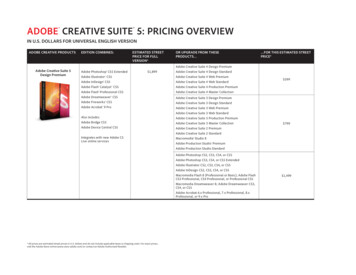

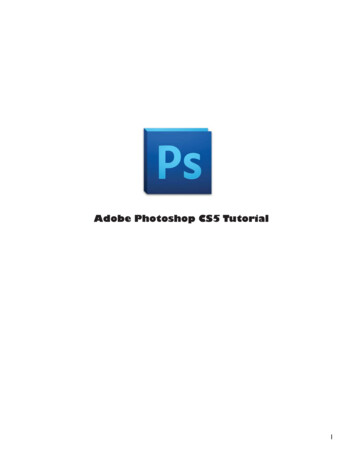
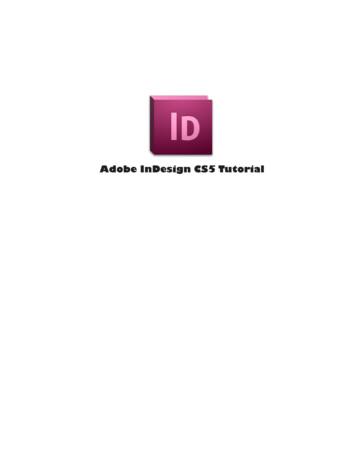

![Adobe Photoshop 2021 (Version 22.1.1) [32 64bit] [2022] - GWBC](/img/64/adobe-photoshop-2021-version-2211.jpg)
